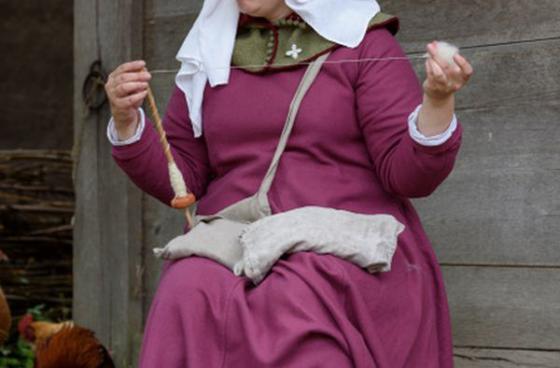During the season, we focus on craftsmanship in the Middle Ages. In selected theme weekends we take different crafts during loving treatment.
At Pentecost (8 - 10 June) we go in depth with the textile craft in the Middle Ages.
Wool is carded and spun, then woven, dyed, cut and sewed to the finished suit. All aspects of textile production can be experienced at the Medieval Center at the weekend.
At the deyer, the yearn is dyed in many different colors and with the tailor, clothes are repaired and produced for the city's better citizenship.
How long does it take to make a whole suit from the wool being sheared from the sheep? What raw materials should you use to color fabric blue? And how do we know what clothes looked like in the Middle Ages?
In the Middle Ages, the garment was an expression of social status. Therefore, cut pattern, color, type of fabric and decoration said a lot about the person wearing the suit. It was a way to show his wealth - for example, by having a blue dress. The color blue comes from the fabric indigo, which was imported from the east. It was therefore extremely expensive. A cloth dyed in blue was one of the most expensive things one could get. The cheapest color was white / gray - that is, the color of the wool is natural.
We have a visit from a foreign re-enactment group called Merry Swan. They come from Finland and Sweden, and they have visited us during their summer holidays. They are all very skilled textile craftspeople and will show and tell about the textile craft in the Middle Ages. They will spin, tabletweave, weave, deye and sew; a delight to the eye. Several of the members work daily with textiles in historical context, and they therefore have a tremendous knowledge that they will happily share and convey on weekends. It will also be possible to see many different costumes in play when the members of the group walk around the city. There is great variation in the medieval dress.
Our knowledge of clothing in the Middle Ages stems mainly from burial finds, where parts of suits were preserved, so you can see pattern and weaving. You can also make analyses and know what colors it had. Illustrations, murals and tombs are also important tools when analyzing medieval clothing.
Saturday and Sunday there will be a free guided tour focusing on the textile workshops at the Medieval Center. Hear our talented communicator, tell about the process from sheep to suit.
Come by, feel the wool, see the beautiful dress take shape and color, try to spin and hear about the exciting and long process it is to make wool for cloth.
Saturday and Sunday at. 10: 00-16: 00 - there are of course also trebuchet shots and the knights tournament!

